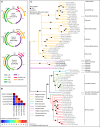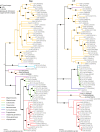Alfalfa Leaf Curl Virus: an Aphid-Transmitted Geminivirus
- PMID: 26109720
- PMCID: PMC4542355
- DOI: 10.1128/JVI.00453-15
Alfalfa Leaf Curl Virus: an Aphid-Transmitted Geminivirus
Abstract
The family Geminiviridae comprises seven genera differentiated by genome organization, sequence similarity, and insect vector. Capulavirus, an eighth genus, has been proposed to accommodate two newly discovered highly divergent geminiviruses that presently have no known vector. Alfalfa leaf curl virus, identified here as a third capulavirus, is shown to be transmitted by Aphis craccivora. This is the first report of an aphid-transmitted geminivirus.
Copyright © 2015, American Society for Microbiology. All Rights Reserved.
Figures




References
-
- Bernardo P, Golden M, Akram M, Naimuddin Nadarajan N, Fernandez E, Granier M, Rebelo AG, Peterschmitt M, Martin DP, Roumagnac P. 2013. Identification and characterisation of a highly divergent geminivirus: evolutionary and taxonomic implications. Virus Res 177:35–45. doi:10.1016/j.virusres.2013.07.006. - DOI - PubMed
-
- Candresse T, Filloux D, Muhire B, Julian C, Galzi S, Fort G, Bernardo P, Daugrois JH, Fernandez E, Martin DP, Varsani A, Roumagnac P. 2014. Appearances can be deceptive: revealing a hidden viral infection with deep sequencing in a plant quarantine context. PLoS One 9:e102945. doi:10.1371/journal.pone.0102945. - DOI - PMC - PubMed
Publication types
MeSH terms
LinkOut - more resources
Full Text Sources

